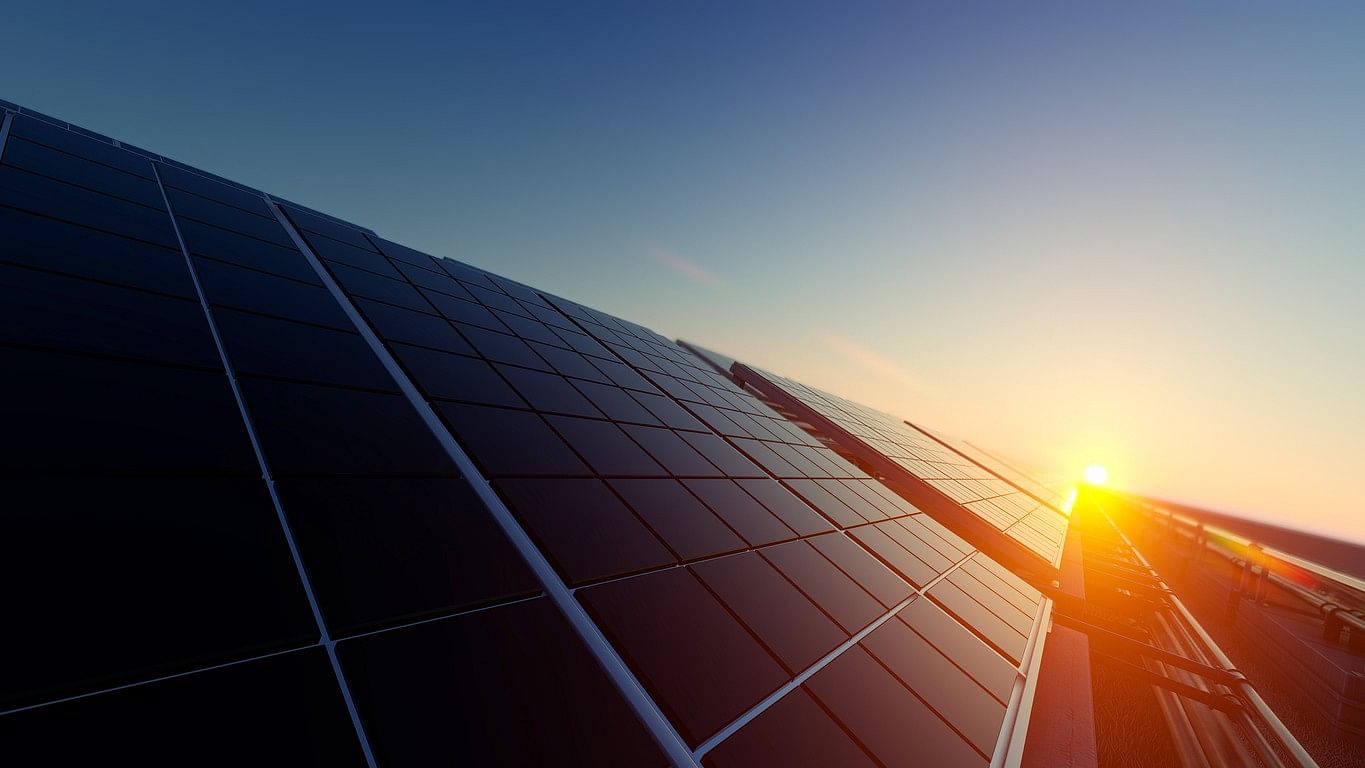
Image showing solar panels. For representational purposes.
Credit: iStock Photo
New Delhi: The country's target of installing 500 GW of renewable energy by 2030 may push solar equipment import bill to about $30 billion per year and increase dependence on Chinese goods, think tank GTRI said in a report on Sunday.
It said developing a self-reliant solar manufacturing industry in India will require significant investment to create an integrated supply chain, especially in areas like polysilicon and wafer production.
Without this, India may continue to face high import costs and struggle to meet its renewable energy goals.
India installed 15 GW of solar capacity in 2023-24, raising the total to 90.8 GW by September, compared to just 2.8 GW in 2014, it said.
To meet the government's target of installing 500 GW of renewable energy by 2030, India needs to significantly ramp up installations to 65-70 GW each year, with over 80 per cent of this target expected to come from solar power, according to the Global Trade Research Initiative (GTRI).
"This target seems ambitious, particularly given India's reliance on imports, which could push solar import to $30 billion annually," it said.
In 2023-24, India imported $7 billion worth of solar equipment, with China supplying 62.6 per cent.
China controls 97 per cent of global polysilicon production and 80 per cent of solar module manufacturing, making it difficult for India or any country to compete due to lower prices from China.
GTRI Founder Ajay Srivastava said while initiatives like the production-linked incentive (PLI) scheme aims to boost local manufacturing, impact is limited as it relies on large scale use of imported inputs.
The report said India's solar manufacturing industry is in early stages, with most projects relying on imported ready-to-use modules.
During the last fiscal year, ready-to-use solar modules' imports reached $4.4 billion. The country also imported solar cells worth $1.9 billion and $1 billion worth of other essential parts such as inverters, and cables, junction boxes, transformers, and other electrical components needed for solar installations.
"Local production is import-dependent and mainly focuses on the final two stages. 90 per cent of solar manufacturing in India involves assembling solar modules from imported cells with 15 per cent local value addition," it said.
It added that few Indian companies manufacture commercial scale solar cells from imported polysilicon or wafers that add 30-40 per cent value locally and no one produces solar cells from scratch-using silica sands.
"To cut down on imports, India needs to produce solar cells starting from silica refining, which involves costly and energy-intensive polysilicon production and requires advanced technology," Srivastava said.
He added that cheap imports disrupt local pricing and the country has to also locally produce aluminum frames, glass, and other materials, which will require strong R&D efforts and government support.
According to the report, China is India's largest supplier, providing $3.89 billion worth of solar cells and modules, which accounts for 62.6 per cent of total imports. It is followed by Vietnam ($1.02 billion -- 16.5 per cent), Malaysia ($549.8 million -- 8.9 per cent, and Thailand ($248.8 million -- 4 per cent).
To reduce dependency on Chinese imports, India imposed a 40 per cent customs duty on solar modules and a 25 per cent duty on solar cells. However, imports from Vietnam, Malaysia, and Thailand are exempt from these tariffs under the India-Asean free trade agreement (FTA), provided they add at least 35 per cent value to the imported inputs used in their export products.
The think tank has suggested seven steps to boost domestic manufacturing and cut imports and that includes pushing investments in upstream solar production, from raw materials like silica sand to finished solar panels, reducing dependency on imported wafers, polysilicon, and cells.
There is also an urgent need to focus on building local production capacity for aluminum frames, glass, and other critical materials used in solar panel manufacturing.
It asked to expand the scope of initiatives like the PLI scheme to cover early-stage solar manufacturing and provide targeted subsidies to attract private investment; and create a skilled workforce capable of managing large-scale solar installations and manufacturing processes.
"India should partner with the US, the EU, and Japan to establish large-scale solar manufacturing facilities, fostering an independent and resilient solar industry," Srivastava said, adding that the country's current import duties on solar modules and cells should be reassessed to ensure they promote local manufacturing without raising costs for consumers.
Further he said the global shift from fossil fuels to renewable energy, led by the US, EU, Japan, and India, hinges heavily on solar power, which makes up 50-80 per cent of the renewable energy mix in most countries.
China now dominates over 80 per cent of global solar production and exports, controlling 97 per cent of the world's polysilicon supply. In 2023, China exported 227 GW of solar modules worth $39.5 billion and 38 GW of solar cells worth $4.2 billion, it said.
Producing solar panels involves six stages, from mining silica sand to assembling the final panel. Most countries import fully assembled solar modules, preferring this route over building domestic capacity.
Due to this dependence, it said the US, the EU, India, and Japan can consider establishing global-scale solar cell manufacturing facilities, starting from scratch.